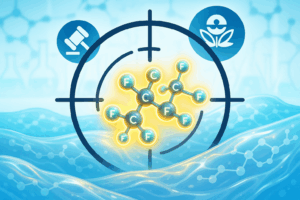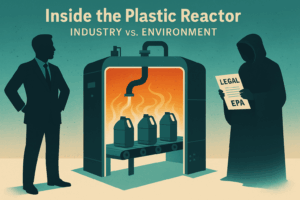
Inside the Fifth Circuit opinion that clipped the Agency’s wings, jolted supply chains, and re‑wired the future of “forever‑chemical” regulation.
The Surprise Inside Your Chemical Jug
By the time federal inspectors walked into Inhance Technologies’ Houston plant in 2022, the company’s fluorination chambers had already treated more than 30 billion high‑density polyethylene (HDPE) bottles.¹ For four decades, those electric‑blue arcs of pure fluorine gas had been the unsung guardians of everything from motor‑oil additives to mosquito pesticides—creating an invisible polymer shell that locks hazardous liquids safely inside their plastic prisons.
What nobody realized—certainly not Inhance, and apparently not the U.S. Environmental Protection Agency—was that the same process was also cooking up per‑ and polyfluoroalkyl substances, the notorious “forever chemicals” known as PFAS. When EPA scientists finally spotted the microscopic hitchhikers leaching into a batch of pesticide in 2020, the discovery triggered a regulatory dogfight that now threatens to redefine how America polices industrial chemistry.
On March 21 2024, the U.S. Court of Appeals for the Fifth Circuit delivered the climax:
“A forty‑year‑old manufacturing process is not new in any pertinent sense of the word.”²
With that one line, Judge Cory Wilson gutted EPA’s attempt to throttle Inhance under the Toxic Substances Control Act (TSCA) using a Significant New Use Rule—and, in the process, threw a legal wrench into Washington’s broader PFAS playbook.
QUICK‑SCAN CASE BRIEF
| Heading | Details |
|---|---|
| Case | Inhance Technologies, LLC v. EPA, No. 23‑60620 (5th Cir. 2024) |
| Issue | Can EPA treat a decades‑old fluorination process as a “significant new use” under TSCA § 5? |
| Holding | No. “New” means recently commenced—not newly discovered by the Agency. |
| Result | EPA’s § 5(f) and § 5(e) orders vacated; Inhance may keep fluorinating while EPA pursues TSCA § 6 rulemaking. |
| Why It Matters | Reinforces statutory limits on agency power; forces PFAS regulation into the cost‑benefit gauntlet of TSCA § 6; shields long‑running industrial practices from surprise shutdowns. |
Anatomy of an Administrative Ambush
TSCA’s Two‑Door House. Congress designed TSCA with separate doors for new and existing chemicals. Door № 1—§ 5—handles brand‑new molecules or significant new uses of old ones. Door № 2—§ 6—deals with long‑standing substances that turn out to be dangerous, but it demands a full dress rehearsal of cost‑benefit analysis before EPA can slam it shut.
By 2020, EPA believed PFAS had become an uninvited guest in too many places and used § 5 to publish a PFAS Significant New Use Rule (SNUR). The rule said: *If you want to make or process long‑chain PFAS in any way that wasn’t going on in 2015, you must notify us 90 days in advance.*³
The problem? EPA never told the plastics‑fluorination world it was on the invite list. Inhance didn’t even know its 1980s‑era trick produced PFAS, so the company never sought an exemption. When the Agency finally pieced it together and fired off a Notice of Violation, it tried to treat Inhance’s process as “new”—because EPA had only just discovered the risk.
 The Court’s Two‑Step Takedown
The Court’s Two‑Step Takedown
-
Plain Meaning Prevails. Dictionaries, said the Fifth Circuit, define “new” as recently come into being. You can’t slap that label on a 40‑year‑old assembly line simply because regulators only now learned what it does.
-
Mind the Statutory Gap. Letting EPA re‑brand old uses as new would let the Agency “swallow § 6 whole,” dodging the math of cost and benefit that Congress built into existing‑chemical regulation. That, the court warned, would eviscerate TSCA’s balance between public health and economic reality.
Net effect: EPA’s emergency orders—one outright ban on three PFAS, another moratorium pending data on six more—were wiped off the books. Inhance’s supply‑chain clients (think automotive lubricants, agricultural herbicides, specialty solvents) exhaled in relief.
“We agree with the appeals court that Congress intended the EPA to consider more carefully the effects of its TSCA regulations on manufacturing.”
— Independent Lubricant Manufacturers Association, March 22 2024⁴
WHY ENVIRONMENTAL LAWYERS ARE STUDYING THIS OPINION LIKE A MAP
| Regulatory Keyword | What Inhance Now Means |
|---|---|
| Fair Notice | Agencies can’t punish industry for clairvoyance failures. If a rule exerts surprise reach, enforcement may collapse. |
| Administrative Overreach | Courts remain keen to police agencies that stretch undefined terms past their commonsense reading. |
| PFAS Roadmap | EPA must steer PFAS controls into TSCA § 6, the slow lane that requires hard economic data and public comment. |
| Litigation Strategy | Companies with legacy processes should audit how long they’ve been running and document reliance interests—strong ammo if regulators pivot. |
The Next Chapter: Slow Cooking in § 6
EPA is hardly surrendering. In July 2024 the Agency granted an Earthjustice petition to open TSCA § 6 rulemaking on PFAS formed during plastic fluorination.⁵ The process will take years, demand peer‑reviewed science, weigh substitution costs, and survive OMB review. Yet environmental advocates say it’s the correct battlefield: transparent, participatory, and statutorily bulletproof.
Meanwhile, Inhance faces a reputational dichotomy: hero to supply‑chain managers; continuing headache to public‑health groups. The company claims ongoing R&D to “eliminate incidental PFAS,” but concrete timelines are hazy.⁶ Traders in barrier‑technology startups smell opportunity.
Block Quote
“Forever chemicals have finally forced us to confront the question of regulatory haste versus statutory faithfulness. Inhance didn’t win a license to pollute; it won the right to a proper hearing.”
— Charles T. House, professor of environmental law, Syracuse University
Keyword Takeaways for the Legal Crowd
-
Environmental Law Compliance
-
TSCA Litigation
-
PFAS Regulation Strategy
-
Administrative Procedure Act
-
Fifth Circuit Environmental Rulings
-
EPA Enforcement Defense
-
Chemical Manufacturing Risk Management
If you advise clients in manufacturing, agriculture, or chemical logistics, clip those phrases—they’re the SEO meta‑tags of tomorrow’s docket searches.
Endnotes
-
Inhance Technologies corporate filings, 2023.
-
Inhance Technologies, LLC v. EPA, 96 F.4th 888, 899 (5th Cir. 2024).
-
EPA, “Long‑Chain PFAS Significant New Use Rule,” 85 Fed. Reg. 45109 (July 24 2020).
-
Independent Lubricant Manufacturers Association (ILMA), Press Release, Mar. 22 2024.
-
EPA, Notice Granting TSCA § 21 Petition on PFAS in Fluorinated Containers, 89 Fed. Reg. 43312 (July 12 2024).
-
Babst Calland, Environmental Alert, “Fifth Circuit Vacates EPA Orders,” Mar. 27 2024.









